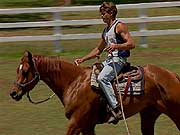Pat Parelli – Calming A Horse That Bucks
Pat Parelli’s theory of horsemanship is based on the prey-predator concept, that is, horses evolved as prey animals and their best defence against predators trying to catch and eat them was to run. Pat explained that bucking is part of the flight response of the horse. Predators often attack horses around the cinch (girth) area, and the horse’s natural instinct is to buck and try and throw the attacker off. Scott Barlow asked Pat to help him calm his horse, and stop it bucking all the time.
Bucking bronco
Pat showed Scott some exercises designed to make the horse feel good by stretching the muscles in the cinch area:
1. Attach the horse to a long, strong lead rope. Swing the rope and tap the horse on the front, then swing the rope towards his hindquarters so that he faces you. Repeat on the other side of the horse.
2. Throw a rope over his back, then pull on it until it tightens around the cinch area. Hold the lead rope in one hand and the cinch rope in the other, and keeping the rope steady, work the horse around you in a circle.
3. Remove the cinch rope, and ask the horse to jump over a low jump in the paddock.
4. Swing a saddle onto the horse’s back in one easy movement. Repeat the first three steps with the horse wearing the saddle.
5. Mount the horse, then instead of kicking him when you want to move off, turn your toes out and squeeze a little. Relax and go with the horse, squeezing again to move up to a trot and then to a canter. If the horse shapes to buck, relax your legs and bend his neck. Work back down through the gaits, then finally breathe out and come to a stop.
6. Practise smooth repetitions of these movements, and in no time at all your horse will behave perfectly without bucking.
Further information
Pat Parelli’s courses are now run in Australia under local accredited instructors. For details contact:
Parelli Natural Horse-Man-Ship
PO Box 2232, Gosford, NSW, 2250
Phone: 1800 627 404



